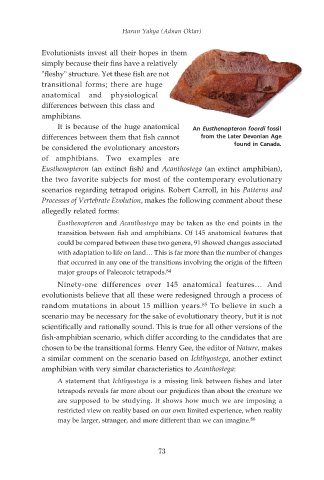Page 75 - Darwinism Refuted
P. 75
Harun Yahya (Adnan Oktar)
Evolutionists invest all their hopes in them
simply because their fins have a relatively
"fleshy" structure. Yet these fish are not
transitional forms; there are huge
anatomical and physiological
differences between this class and
amphibians.
It is because of the huge anatomical An Eusthenopteron foordi fossil
differences between them that fish cannot from the Later Devonian Age
found in Canada.
be considered the evolutionary ancestors
of amphibians. Two examples are
Eusthenopteron (an extinct fish) and Acanthostega (an extinct amphibian),
the two favorite subjects for most of the contemporary evolutionary
scenarios regarding tetrapod origins. Robert Carroll, in his Patterns and
Processes of Vertebrate Evolution, makes the following comment about these
allegedly related forms:
Eusthenopteron and Acanthostega may be taken as the end points in the
transition between fish and amphibians. Of 145 anatomical features that
could be compared between these two genera, 91 showed changes associated
with adaptation to life on land… This is far more than the number of changes
that occurred in any one of the transitions involving the origin of the fifteen
major groups of Paleozoic tetrapods. 84
Ninety-one differences over 145 anatomical features… And
evolutionists believe that all these were redesigned through a process of
random mutations in about 15 million years. 85 To believe in such a
scenario may be necessary for the sake of evolutionary theory, but it is not
scientifically and rationally sound. This is true for all other versions of the
fish-amphibian scenario, which differ according to the candidates that are
chosen to be the transitional forms. Henry Gee, the editor of Nature, makes
a similar comment on the scenario based on Ichthyostega, another extinct
amphibian with very similar characteristics to Acanthostega:
A statement that Ichthyostega is a missing link between fishes and later
tetrapods reveals far more about our prejudices than about the creature we
are supposed to be studying. It shows how much we are imposing a
restricted view on reality based on our own limited experience, when reality
may be larger, stranger, and more different than we can imagine. 86
73

